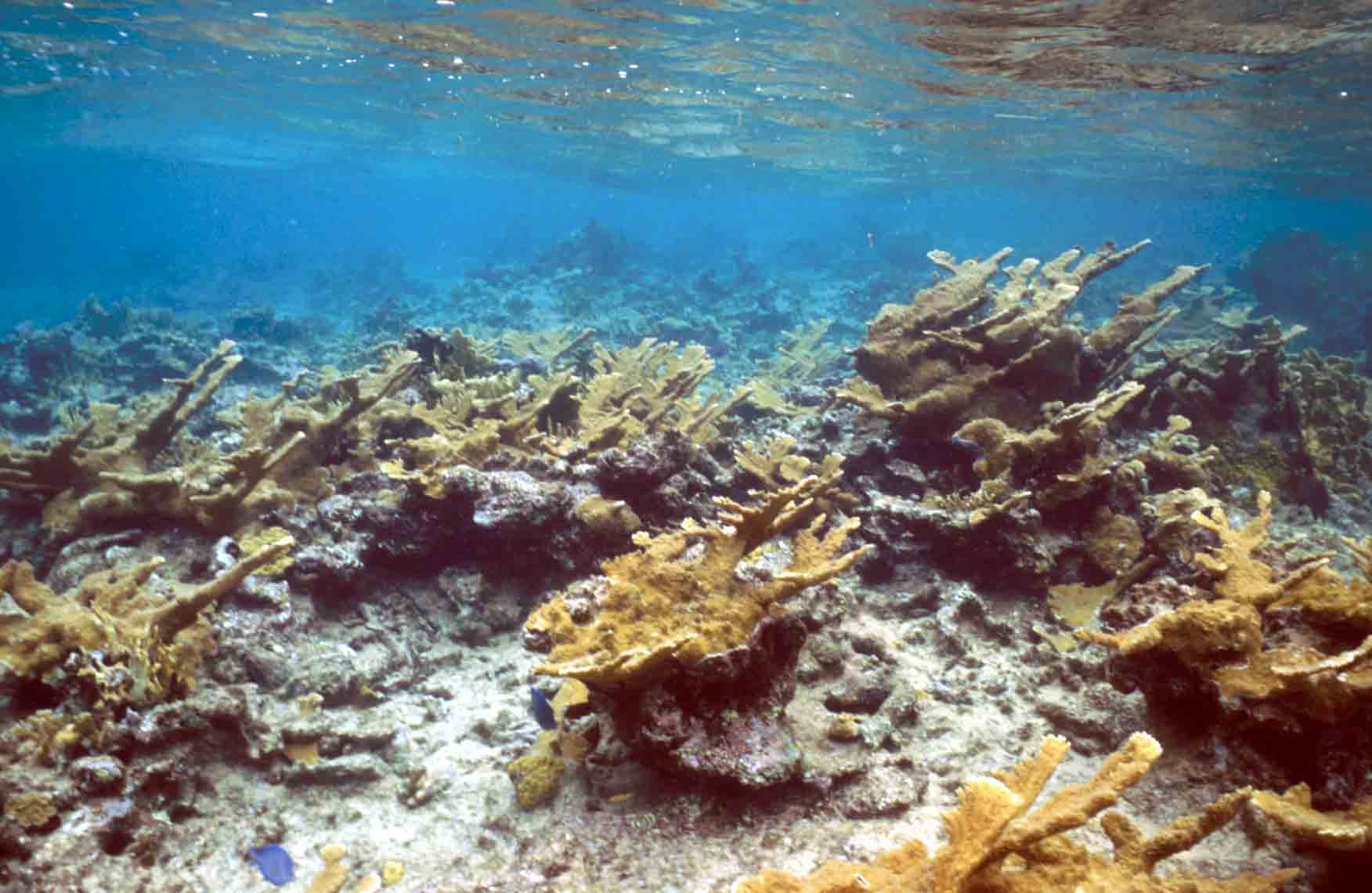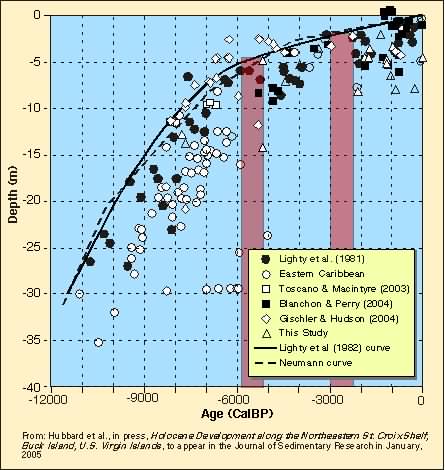The photograph to the right shows the reef crest in Buck Island Underwater National Monument in 1977. At that time, the shallow reef was dominated by the branching corals Acropora palmata (shown) and A. cervicornis. Starting in late 1977, White Band Disease atacked these species and all by extirpated them from the Caribbean over the coming few years. The name is derived from the narrow front of diseased coral tissue which exposed white skeleton beneath. As the band progressed along the branch, color on either side reflected either healthy coral tissue (in front of the advancing band) or invasive algae that colonized the recently killed surface. This disease was first described by Bill Gladfelter at Buck Island. It did not receive significant ettention until it was later described in the Florida Keys. Today, A. palmata is the "poster child" of Caribbean coral-reef decline and has been considered as a candidate for the U.S. Endangered Species List. The present debate centers around whether this recent loss is an unprecedented anthropogenic event or reflects part of a larger boom-and-bust cycle that is natural.

The graph to the right summarizes available Acropora palmata dates from Caribbean platform. These are derived from our studies plus the literature. Samples were collected by coring through the reefs with various drilling systems that follow the original design of Ian Macintyre. The y-axis is the depth below (present) sea level at which the samples were recovered. The x-axis is radiocarbon years before present (corrected to CalBP).
The curves on the graph represent our best approximation of sea-level for the past 12,000 years. The solid curve was proposed by Robin Lighty who assumed that by plotting enough data points one could draw a curve over the top of the shallowest ones as an approximation of the reef crest position over time. The vertical scatter along the depth axis would reflect the known depth range of the species (ca. 10 m). The dashed line is the unpublished curve of Conrad Neumann based on peat dates from Bermuda. The samples that plot above the curve are from storm beaches deposited above sea level. The general agreement of the peat and Acropora curves lends support to each.
This plot also shows the temporal history of A. palmata
throughout the Caribbean Sea over the past 12,000 years. Note that
there are two intervals (pink) where either A. palmata decreases
significantly in its frequency of occurrance or is absent altogether.
These are interpreted as intervals during which A. palmata declined
in abundance. This story has been chronicled in a recent Proceedings volume
for the 11th Bahamas Congress (San Salvador) and is part of a paper scheduled
for publication in JSR in January of 2005.

What do we know?
-
Based on all samples known so far, the abundance of A. palmata appears to have declined twice in the past 12,000 years.
-
The "event" appears to ba Caribbean-wide based on the geographic variability of samples sites.
-
No meteorological or oceanographic parameter occurrs consistently at the majority of the sites examined.
-
Sea level was not rising fast enough at either time to cause a sudden deepening that might explain the loss of branching acroporids
-
The synchronicity arfues for a cause operating on at least a regional scale.
What do we think?
- Evaluation of likely causes has ruled out everythin except disease and bleaching.
-
It would be better to find positive evidence to support one of these possibilities.
-
Nevertheless, the existence of the gaps should not be ignored until a cause is unequivocally identified.
-
Unresolved issues seem critical to our understanding of past changes in coral-reef community structure.
-
They are likewise critical for separating anthropogenic decline from natural change. Thus, the past may be the key to the present...... and the near future.
Where from here?
Both bleaching and disease leave the colony standing. This is in direct contrast to the more typical mode of Acropora preservation - breakage and rapid deposition during storms. We have recently collected over 100 branches of A. palmata that were killed in the late 1970s and early 1980s by White Band Disease. The colonies were collected from two sites where Bill Gladfelter first described the epidemic in Buck Island Underwater National Mounment. The patterns of encrustation and bioerosion (see "Acropora Taphonomy" on Research Home Page) are being quantified and compared to samples collected from 2-m deep excavations at the same sites. It is presumed that different post-mortem "fingerprints" will be associated with each mode of deposition. Eventually, we hope to compare these to Acropora samples in our core archives kept at Oberlin College.